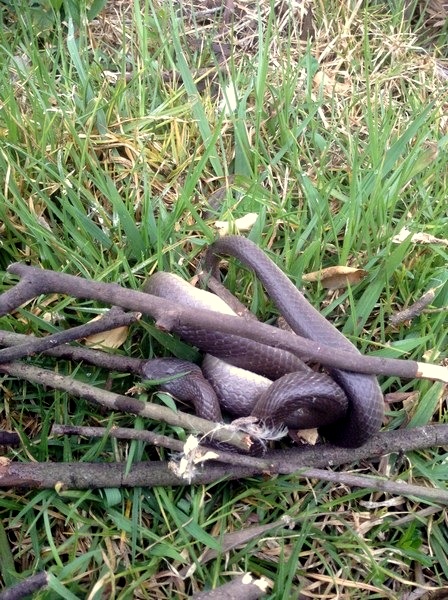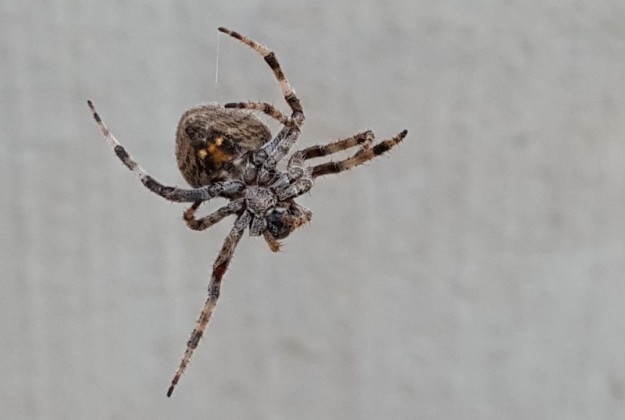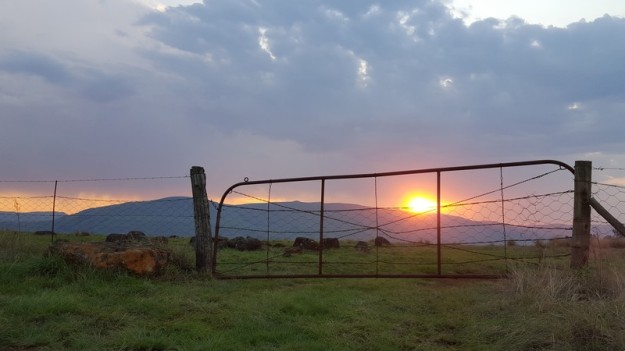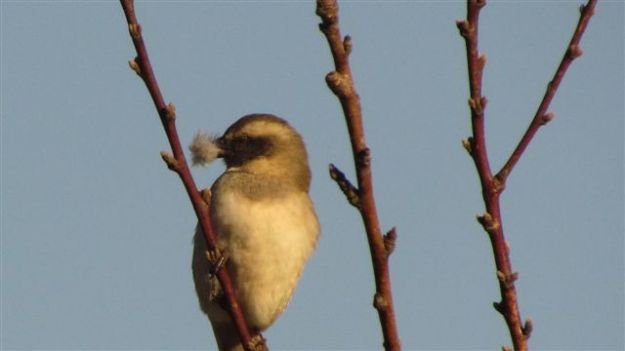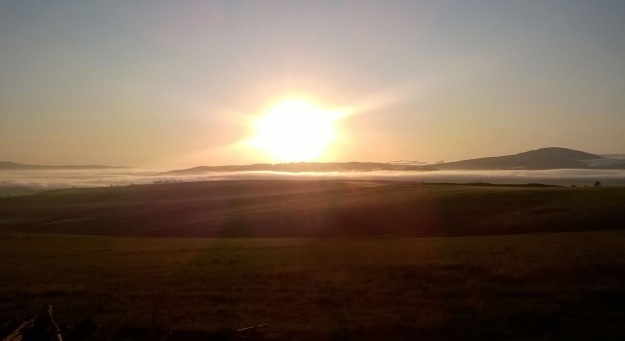We were sad to hear that David Clulow passed away during October. David was the inspiration behind our Wildlife Sightings, having started collecting monthly records in Boston many years ago. He was pleased that other Conservancies had followed his example, and always sent supportive notes when he received the latest edition. We will miss his witty and clever comments.
October has been an extremely dry month for us here in the Dargle. With only a few millimeters of rain received near the beginning of the month, we had almost nothing until this past week when a few drops finally fell to cool down the parched earth. Hopefully this means that the big rains will be coming soon!
We have some great images and stories to share, so let us take your mind off your normal daily worries, and be transported to the enchanting forests and valleys of The Dargle, in the KZN Midlands…
David Crookes – Copperleigh Farm

South African shelduck or Cape shelduck (Tadorna cana), this is the female

A Male Shelduck keeping watch from the jetty

Shelduck Family, only 3 of the original 8 babies are left

How to do the “Shelduck Bob”…

Male Shelduck being chased by Egyptian Goose

Life is tough, living on a farm dam

Spurwing Goose standing on wooden pole

A Pair of Blue Crane flying overhead

The Amethyst sunbird, also called the black sunbird (Chalcomitra amethystina)

Juvenile Gymnogene, checking out the weaver nests
Eidin Griffin
Puffadder caught by Mlungisi.

Puffadder caught by Mlungisi
Nikki Brighton – Old Kilgobbin
This month, for the first time ever I saw a Tambourine Dove. It may not be rare or unusual, but it was very exciting for me!

Tambourine Dove
A group of big egrets were in the water and roosting in the dead tree beside the dam one morning, I have never seen them here before, either. Are they Yellow-billed Egrets?

Who’s this Egret?
Have often heard Burchell’s Coucal (will have to change it’s common name ‘Rain Bird’, I think), occasionally a Buff Spotted Flufftail and of course, all the cuckoos – Emerald and Klaus’ – Red Chested first heard on 9 October, with African Black on 10 October. I have not heard the Diederick yet. Spotted this clump of Spurwinged Geese early one morning.

Spur-winged Geese
Always good to find familiar spring favourites in the grassland, like Senecio speciosus.

Senecia speciosus
Eulophia clavicornis – The colour of the flower is variable, ranging from purplish brown to dark green with a white or purple or yellow fleshy lip. One reference I came across described Eulophia clavicornis as a ‘mauve pixie’ which seems just perfect.

Eulophia clavicornis
Learn more about Eriosema disctinctum:

Eriosema distinctum
Eriosema Kraussianum – The silvery stems are covered in silky hairs which set off the pale yellow flowers perfectly. For centuries, Zulu men have drunk hot milk infusions or boiled root decoctions made from Eriosema to treat impotence. In 2006, research undertaken by the University of Natal found that key compounds in the plant are effective in tackling this problem.

Eriosema kraussianum
Senecio oxyriifolius with fleshy, nasturtium like leaves and flowers help aloft on long stalks.

senecio oxyrifolius false nasturtium
Kouhautia amatymbica are flowering profusely – must like the dry weather.

Kouhautia amatymbica
Clerodendrum hirsutum Wild violet, in the grassland.

Clerodendrum hirsutum
Beside a stream bed (no water flowing) a splendid, shoulder high Crinum macrowanii

Crinum macrowanii
Found some more unusual plants too like Schizoglossum cordifolium Common Split tongue

Schizoglossum cordifolium
Asclepias cucullata Hooded Meadow Star

Asclepias cucullata
Have seen one oribi, two bush buck and a few reedbuck and common duikers. Lots of evidence of wildlife in the damp edges of the dam. There are great swathes of Senecio bupleuroides (I think) which flower in recently burnt areas.

Senecio bupleroides mass
Up close the flowers are too pretty for words. Commonly known as Yellow Starwort.

Senecio bupleroides
Finding this damselfly was a treat! Not sure what it is. Help anyone? Perhaps it is actually an antlion?

Who’s this Damselfly?
I am always pleased to come across a dung beetle, there don’t seem to be nearly enough around.

Dung Beetle
Fields of daisies (I think Adenanthellum osmitoides)

White daisies
Derek & Sue Miller
Natal Green Snake, not very sharp as it was shot in a hurry! We used the markings on the wall to measure the snake’s length of well over 1.5metres.

Natal Green Snake
Ashley Crookes – Copperleigh Farm
A couple weeks ago I was checking up on our little stream which runs through the natural bush on our farm. Thankfully it was still running, providing water further down for some of our animals.

Even through the worst part of the drought this little stream still flowed from underground
I also managed to sneak up to within 3m of an Olive Woodpecker before he got nervous of myself and the cellphone camera

Male Olive Woodpecker (Mesopicos griseocephalus)
He left quite a few holes in one of the little trees…

Holes in wood from woodpecker
…as well as a significant pile of “saw dust”!

Sawdust from woodpecker
There was a fire (November) recently which burnt a large portion of farmland – just to give you all an idea of how dry it has been.

Fires started last week near the chicken farm
A massive Aardvark hole at the top of our farm

Massive Aardvark hole on the farm
Spiderweb on the ground captured the recent rain

Spiderweb on ground captured the rain
The Dargle Valley should start to look a little greener now, after the recent rains

View of the valley from up high
I wasn’t sure what this dead snake was, so sent it to Pat McKrill for his expert opinion: ” It’s a Cross marked, or Montane grass snake, probably got a new common name now, but still Psammophis crucifer. Although venomous, completely harmless, and feeds on lizards and frogs. Good find, not often seen, pity that it’s got to the end of the road before time.”

Cross marked, or Montane grass snake
Some lovely skins found in the garden, courtesy of the Natal Green Snakes!

Snake skins found in garden most likely from Natal Green Snakes
Brian & Marashene Lewis – GlenGyle
Everyone looks at plants and animals. After the lovely rains the forest fungi are flourishing. We noticed 3 specimens today.
The yellow fungus is Pycnoporus Sanguineus. (Cinnabar Bracket)

Pycnoporus Sanguineus. (Cinnabar Bracket)
The white fungus appears to be Auricularia Auricula-judae (Jews ear)

Auricularia Auricula-judae (Jews ear)
Best game camera photo for September. I desaturated a day photograph – Bushbuck Ram

Bushbuck Ram
Malvina van Breemen – Old Furth Estate
We have been privileged this month to see a caracal right near the house in our hill paddock, although we are wondering whether it was scoping out one of our Nguni calves or coming closer to check on our free-roaming ducks and Bushveld chickens! There’s a caracal in this photo – somewhere at the bottom of a clump of grass…

Caracal hidden in the grass somewhere
We have also had numerous Natal dwarf chameleons around the house, male and female and so look forward to a crop of tiny, itsy bitsy babies soon.
The spoonbill has been very busy in our super-low dams, along with several sacred ibis and the first Piet-My-Vrou started calling on the 7th of October.

Spoonbill making the most of the low water levels
The first swallows were spotted here on the 15th of October and the Swifts and Martins just before that. The raptors have been very busy overhead and our Gymnogene has been causing havoc with the Weavers. The Blue and Crowned Cranes have been spotted flying overhead and landing on various parts of the farm.
The Bushbuck have been very active on the hill near the house and we have seen the magnificent male a few times on the road going up the hill. He is a very watchful chap and we often hear him ‘barking’ at night whenever something disturbs them.

Inhlosane viewed from Old Furth Estate
We also had a rather noisy and large fruit beetle land in our kitchen – I knew them by the Afrikaans name of “Tor” but think it may be a CMR beetle in English

Beetle
The baboons are obviously getting really hungry and munched through a couple of cables on one of our WebSmart Wireless Broadband masts, thereby decommissioning everyone’s connections to that high site! Frustrating for all concerned…..
Jenny Fly – Kildaragh Farm
So hot , so dry , but we all press on hopefully , and as night follows day, so we hope the rain must come.

A beautifully patterned moth

Despite the drought and heat , indigenous plants and trees in the garden are valiantly blooming.Scilla natalensis or blue squill

Thunbergia natalensis. The Natal Bluebell.

The little Ochna natalita tree with it’s cheerful yellow flowers


Monsters in the garden, that appeared one mizzly evening.

Monsters in the garden, that appeared one mizzly evening.
Lara Kirsten and Kim Goodwin – Woodstock Farm, Lidgetton

Unknown – Bagworm moth larvae
Neville van Lelyveld : Farm Report for Iain Sinclair, Benn Meadhon Farm
Oribi: During both visits we only saw 5 Oribi, 3 female and 2 males in the Oribi Paddock all of the other Oribi from the second herd that lived above the maize paddock have disappeared. This is a major blow to our Oribi project as we have had a reduction from 15 to 5 ever since the February issue. One bit of good news however is that “Baby Girl” one of our babies from 2013 is now pregnant. We noticed this during our September visit and confirmed it during our October visit. She is already withdrawing from the main herd so she is close to delivery. This is a big thing for us as she was one of our babies that is now pregnant so it is very special for Hayley and I. We will be closely monitoring them from slightly more of a distance over the next few months and we will also monitor the jackal movement and presence in this paddock from now on, in order to ensure the survival of this very precious baby on the way. She still let us within our normal 5m range of her.
Reedbuck: There has been a major reduction in the reedbuck population from 27 animals during our September visit to a total of 12 female only. All the males have been poached out. It is very obviously that these males have been “professionally” poached or shot as only the males have been taken. This poaching of the males only is obviously for their horns as trophies as they are of a taxidermist value as trophies for sale to the general public. These trophies can fetch several thousands of rand each. This situation will also be closely monitored and the perpetrators will be brought to book.
Grey duiker: Sadly only 3 duiker females were observed and once again as per the Reedbuck all the males have been poached again for their horns as trophies as a taxidermist value. As with the Reedbuck we will be monitoring this closely and the perpetrators will be brought to book as well as any other accessories involved in this poaching going on, on the farm. This is very clearly not the local with snares as the poaching is done far to selectively and professionally.
Jackals: During the September visit while we were observing the nocturnal wildlife we heard someone on the farm using an electronic jackal caller on the farm fairly close to the cross road area. We saw no jackals that night. The question then has to be asked who did and who were they? A very big concern for the welfare of the wildlife.
Bushbuck: No Bush buck have been seen on the farm since January 2015. There is however bush buck scat and tracks to be seen on the farm in certain areas, but even this is nowhere near as much as what was seen prior to February this year. The distinct reduction in scat and track presence since February does prove a major reduction on the farm.
Conservation Award:

Neville van Lelyveld received the J.F.King Conservation Trophy from KZN Hunting and Conservation Association recently for his work in conservation, particularly in Dargle. Neville believes that this is an example of how hunters and conservationists can work together for the greater good of indigenous wildlife and hope that his work inspires other hunters to get involved in similar projects. “This is a team effort” he said, thanking in particular Iain Sinclair of Benn Meadhon, Dr. Ian Little from EWT, Brian and Teresa Jones of SACAN, Dargle Conservancy, Kim Gillings Ezemvelo DCO, Howard Long, Rob Hanbury, Graham Freese, Katie Robinson, AP Smith and Robin and Sharon Barnsley.
Pat and Sandra Merrick – Albury Farm
Most evenings we had ten reedbuck grazing in the dry dam below us – 3 males and 7 females – one evening the 2 males were fighting until it got too dark for me to see – I was concerned that they would get injured with their large horns but Pat assured me that he did not find any injured animal the next day. The secretary bird has been walking the hills for a few weeks.

A male spurwing goose arrives on some mornings and sits or stands on the rock on top of the hill behind us, admiring the view.

Spur-winged Goose
We saw 2 oribi running up the hill one day (male and female) – the male looked like he only had one very long horn but was difficult to see as they were running.

Oribi
On the 17th, 3 wagtails were born in the jasmine creeper – i took a photo of them at ten days old and the next day they had vanished – they certainly did not look ready to fly – looked all over for them but no luck – I wondered if the owls may have eaten them – they were living under the eves close by – the barn owls have now left.
On the 20th, 2 cape robins were born in a honeysuckle creeper – I checked them today and they are getting quite large now but still with lots of fluff.


Pat saw a serval at 7am on the driveway one morning.
A few days ago while having tea on the verandah Pat and I heard jackal buzzards – we went outside and saw what looked like mom giving her 2 fledglings a lesson in flying – there was lots of conversing – the youngsters seemed to flap madly at times, while mom glided swiftly and smoothly through the thermals. When one went up too high she flew up and brought him down, still with lots of chat between them all. It was a very heartwarming sighting.
We have 3 pairs of white throated swallows nesting around under the eves of the house in the corners. The one pair decided to make their mud nest in a cup shape on the same glass lamp shade that the black female sunbird built on last year (we left that nest there in the hope that she would return)

Female Amethyst Sunbird enjoying the Protea flowers
Instead, the female Amethyst sunbird decided to build her nest on a piece of string with 2 crystal baubles tied to it – this has hung on our back verandah for 5 years now – my daughter got married and made a whole lot of hearts and baubles for wedding decoration and I brought one home. Over the years the wind has broken most of it, just leaving about 9 inches of string (too old to work out cm). She started building on the 17th – I have watched her for 2 weeks now as I still have a broken ankle and moon boot, so plenty time to observe our wonderful wildlife.

Amethyst sunbird starting the nest
Sunbird starts at 5am and goes through till 6pm = each trip lasting approx 30 secs –If you had to work out the mileage it would run into a number of kms each day. Every few hours she stops to feed on my alstramerias and bottle brushes. One day when it drizzled she did not work on the nest – probably the wet material would rot the rest of nest or else too difficult to break the pieces of grass, not sure. After ten days of building she started collecting lichen to decorate the outside of the nest – she found a number of feathers in the gutters where the rock pigeons and sparrows sit.

Male Amethyst Sunbird
Sometimes she would sit on the balustrade and turn her head left and right to check and see that everything was as it should be – sometimes her partner would arrive and sit on my hanging basket and chat to her –probably telling her to get a move on!!

Female Amethyst Sunbird
Its the 31st today and she is still at it – she has made the hole in the entrance smaller and now lining the inside of nest. Its 2 weeks since she started building. Doing it all on her own. She has been stopping work at 3pm now. I think she becomes exhausted. I always know when shes there as she always arrives with loud cheeping. As my study looks out onto the verandah, I am very fortunate to be able to see her clearly. I am sure there are birds where both male and female help with the nest building. Amazing. I am in awe of God’s creation.

Female Amethyst Sunbird with a gorgeous nest
We have sparrows in all 4 corners of the house – mostly on top of the gutters – fortunately have not had much rain – some years the nests have been swept down the gutters.

Southern Grey-headed Sparrow
Woke up one cold morning to find the dogs had killed a night adder outside the garage – then 2 weeks ago, also on a cold overcast day, my gardener killed a puff adder. Sorry Pat McKrill, I know you will not be impressed.

I took a picture of a raptor in our gum trees which we could not identify – I sent it to Dr David Allan in Durban and he said he thought it might be a juvenile jackal buzzard.

Caught this cape robin fluffing her feathers after a rock pool bath – she looks like a fat clown

Cape Robin-Chat


Duiker

















































































































































































































































































































 which didn’t seem at all worried about all the commotion it was causing. It slowly slithered through the grass, and went down the drain pipe.
which didn’t seem at all worried about all the commotion it was causing. It slowly slithered through the grass, and went down the drain pipe.





































































































































